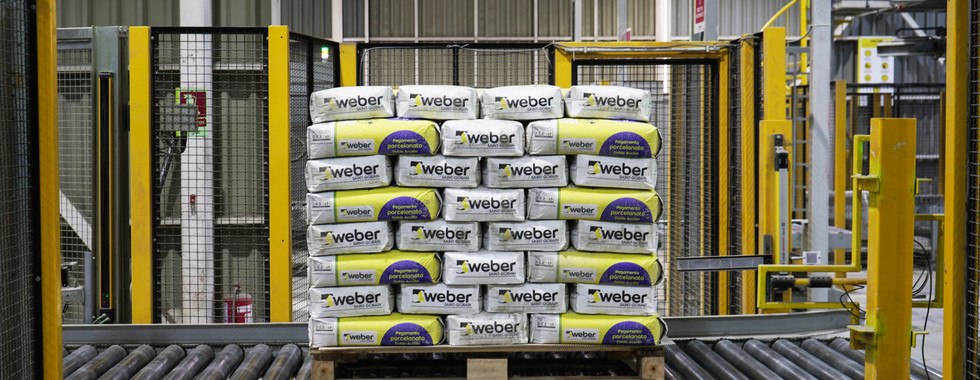Nationwide presence servicing the construction industry
- Jassen Pintado
- Aug 30, 2021
- 4 min read
Updated: Nov 23, 2021
Saint-Gobain Weber has kept a steady presence all along Chile, achieving this accomplishment is possible thanks to the company’s successful strategic partnerships

PARTNERS
Conceived for royalty for global availability
Saint-Gobain designs, manufactures and distributes materials and solutions for industries such as construction, healthcare and mobility, among many others. The company’s history goes back more than three centuries ago as a glass factory opened under orders of King Louis XIV, in France. Currently, Saint-Gobain has presence in 70 countries with the support of more than 167,000 employees, and in 2020 generated sales for more than $45.4 billion.
Products created by Saint-Gobain are developed under a continuous innovation process and are to be found in many different spaces in everyday life, delivering wellness, execution and safety, undertaking the challenges faced by sustainable construction, resource efficiency and fighting climate change.
Boosting presence through partnerships
Saint-Gobain’s presence in Chile also goes back long ago. The company has established key strategic partnerships with businesses such as the El Volcán company and the Vidrios Lirquén glass factory. In 1996, Saint-Gobain incorporated Weber, also a company with French origins and global presence. In 2016, Weber’s affiliate in Chile expanded in South America after acquiring the Solcrom company, a solid player in the production and distribution of chemical products for construction.
The operation in Chile currently has five distribution centers and two production plants, the newest one opening in July 2021 in Concepción, consolidating the company’s presence in all of Chile.
Asier Amorena is the General Manager for Weber Saint-Gobain in Chile since 2017. Amorena is originally a telecommunications engineer, graduated from the Public University of Navarre (Spain), he worked in this specialty during two years for Agilent Technologies in Stuttgart, Germany. Once back in Spain, Amorena was hired at Saint-Gobain for the Marketing and Development department, for which he earned an MBA from the Barcelona School of Management (Spain), adjunct to the Pompeu Fabra University. Besides this degree, Amorena has also taken different marketing courses and seminars in prestigious institutions in Spain, such as IESE, IE Business School and ESADE Business School. His career in Saint-Gobain took a turn in 2011, as Amorena arrived at Brazil as Marketing Director, being named Sales Director five years later; his stint in Brazil also saw Amorena’s further development in leadership by honing his skills in important business schools with professors with ties to Harvard University and the MIT (Massachusetts Institute of Technology), both in the United States.
Nationwide portfolio availability
Solutions and products from Saint-Gobain Weber are useful in projects of different kinds and dimensions: from repairs, finishes and home remodeling projects to large building construction, offering cement, plaster, mortar, coating, sealers, concrete, silicone and other compounds. These products are available from Arica to Punta Arenas through the three main distribution channels for the Chilean construction industry: • For the retail market via SODIMAC, the specialized home and construction superstore chain
• Hardware stores
• In construction companies nationwide.
Growth via digitization
The Digital Transformation process at Saint-Gobain Weber Chile is a key factor to the company’s growth with the development of three main pillars:
• Optimization of managerial procedures
• Improving communication along with thrusting the Weber brand into a digital habitat inclusive to retail clients as well as end consumers of the company’s products, which are mainly contractors and other construction professionals
• The modernization of the company’s industrial platform through resources set in the Industry 4.0 concept.
Partners, shareholders, stakeholders
For decades, the way to success in Chilean territory for Saint-Gobain Weber has been through the creation of powerful partnerships able to bring win-win situations within a context of absolute and total trust. Both the company and partner El Volcán share this long-term perspective.

“We try to bring a fair value offer to our clients and suppliers. A perspective of value distribution of the shareholder to all of our stakeholders, besides facing the everyday challenge of having a true empathic view with each of our stakeholders,” Amorena declared.
Relationships with suppliers
The provision of supplies, raw materials and other goods to run operations in Saint-Gobain Weber Chile requires specialized purveyors, possessing key traits, such as flexibility, being on time and other attributes which allow establishing fruitful relationships in the long term. The company has developed key suppliers as well as products with specific requirements, contributing with knowledge and financial support to its value chain.
“Suppliers with operations in Chile are key partners, because they are open to create custom developments adding value to our operations,” the executive said.
Contributions to a better place
The “Making the World a Better Home” initiative is a global effort from Saint-Gobain and affiliate companies to help make our surroundings a more sustainable, beautiful place to inhabit.
In facing this commitment, Saint-Gobain takes its global leadership role for sustainable solutions and focuses on goals such as reaching a zero CO2 emissions by 2050. This was announced during the UN Climate Action Summit.
This goal contributes to the Business Ambition for 1.5°C global pact, which establishes a maximum increase of global temperature to 1.5°C, considered by science as the limit increase to avoid the worst impacts derived from climate change.
Upcoming plans
Among the upcoming goals for Saint-Gobain Weber in Chile, the operational platform optimization project stands out, as it does the development of work teams into an intermediate skills mix. It’s been foreseen that once these efforts result in efficient processes and skilled individuals, these will add value to the operation, leveraging growth for the company in the upcoming years.





































Comments